NCERT Exemplar Solutions for Class 9 Science Chapter 6 Tissues
These Solutions are part of NCERT Exemplar Solutions for Class 9 Science . Here we have given NCERT Exemplar Solutions for Class 9 Science Chapter 6 Tissues
Question 1.
Animals of colder region and fishes of cold water have thicker layer of subcutaneous fat. Describe why ?
Answer:
Subcutaneous fat functions as insulating layer that prevents heat loss from the body in colder environment. Therefore, animals of colder areas and fishes of colder water possess thicker layer of subcutaneous fat. Fat also functions as reserve food during periods of scarcity.
More Resources
- NCERT Exemplar Solutions for Class 9 Science
- NCERT Solutions for Class 9 Science
- Value Based Questions in Science for Class 9
- HOTS Questions for Class 9 Science
- Previous Year Question Papers for CBSE Class 9 Science
Question 2.
Match the items of columns A and B.
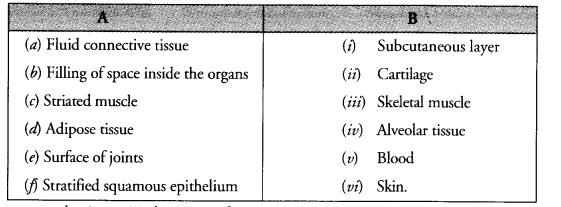
Answer:
a—v,
b—iv,
c—iii,
d—i,
e—ii,
f—vi.
Question 3.
Malch lhe column A witli column B.

Answer:
a—i,
b—ii,
c—iv,
d—iii,
e—v.
Question 4.
If a potted plant is covered with a glass jar, water vapours appear on the wall of galss jar. Explan why ?
Answer:
Plants lose water vapours in transpiration from their leaves and young stems. When a potted plant is placed inside a glass jar, the water vapours cannot escape but remain inside. The wall of the glass jar being cool, water vaours condense there.
Question 5.
Name the different components of xylem and draw a living component.
Answer:
Xylem is made of four components — tracheids, vessels (tracheae), xylem fibres and xylem parenchyma. Only xylem parenchyma is the living component.
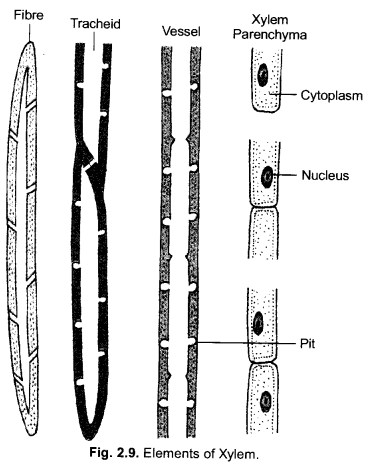
Question 6.
Draw and identify different elements of phloem.
Answer:
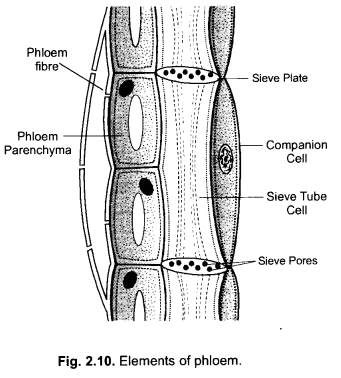
The various components are phloem fibres, phloem parenchyma, sieve tubes and companion cells.
Question 7.
Write true (T) and false (F).
(a) Epithelial tissue is protective tissue in animal body.
(b) The lining of blood vessels, lung alveoli and kidney tubules are all made up of epithelial tissue.
(c) Epithelial cells have a lot of intercellular spaces.
(d) Epithelial layer is permeable layer.
(e) Epithelial layer does not allow regulation of materials between body and external environment.
Answer:
a—T,
b—T,
c—F,
d—T,
e—F.
Question 8.
Differentiate between voluntary and involuntary muscles. Given an example of each type.
Answer:

Question 9.
Differentiate the following activities on the basis of voluntary (V) or involuntary (IV) muscles.
(a) Jumping of frog,
(b) Pumping of heart
(c) Writing with hand
(d) Movement of chocolate in your intestine.
Answer:
a—V,
b—IV,
c—V,
d—IV.
Question 10.
Fill in the blanks :
- Lining of blood vessels is made up of ……………… .
- Lining of small intestine is made up of ………….. .
- Lining of kidney tubules is made up of ……………. .
- Epithelial cells with cilia are found in ……………… of our body.
Answer:
- squamous epithelium
- columuar epithelium
- cuboidal epithelium
- respiratory tract.
Question 11.
Water Hyacinth floats on water surface. Explain. (CCE 2012)
Answer:
Water Hyacinth has spongy petioles which enclose a lot of air in its aerenchyma. Air makes the plant lighter than water so that it is able to float on surface of water.
Question 12.
Which structure protects the plant body against the invasion of parasites ?
Answer:
Epidermis is the outer protective layer of plant body which does not allow the parasites to gain entry into the internal tissues due to
- Absence of intercellular spaces
- Thick outer walls
- Deposition of cutin and wax in the cuticle covering the epidermis
- Silica and other deposidons.
Question 13.
Fill in the blanks :
(a) Cork cells possess on …………….. their walls that makes them impervious to gases and water.
(b) ……………. have tubular cells with perforated walls and are living in nature.
(c) Bone possesses a hard matrix composed of …………….. and ……………
Answer:
a —suberin,
b —sieve tubes,
c—calcium, phosphorus.
Question 14.
Why is epidermis important for the plants ?
Answer:
- Strength: Collenchyma is a living mechanical tissue which provides both mechanical strength as well as flexibility. Because of collenchyma, plant organs can bend without breaking.
- Growth: Collenchyma allows growth and elongation of organs.
- Storage: Being living tissue, collenchyma stores food.
- Photosynthesis: Collenchyma cells may contain chloroplasts and take part in photosynthesis.
Question 15.
Fill in the blanks :
- …………….. are forms of complex tissue.
- …………….. have guard cells.
- Cells of cork contain a chemical called ……………..
- Husk of coconut is made of ……………. tissue.
- …………… and …………….. are both conducting tissues.
- …………….. gives flexibility in plants.
- Xylem transports …………….. and ……………. from soil.
- Phloem transports ……………… from …………….. to other parts of the plant.
Answer:
- Xylem and phloem
- Stomata
- Suberin
- sclerenchyma
- Xylem, phloem,
- Collenchyma
- water, minerals
- food, leaves.
Question 16.
Differentiate between sclerenchyma and parenchyma tissue. Draw diagram as well.
Answer:
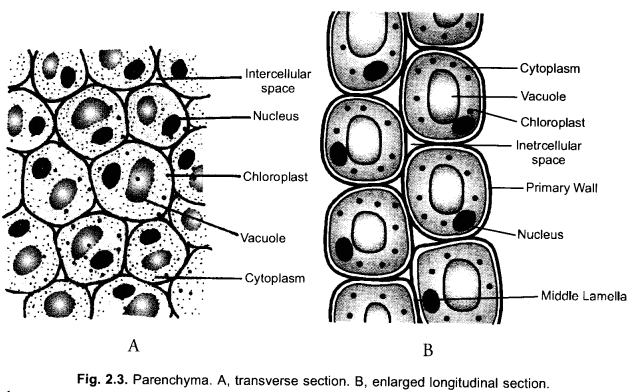
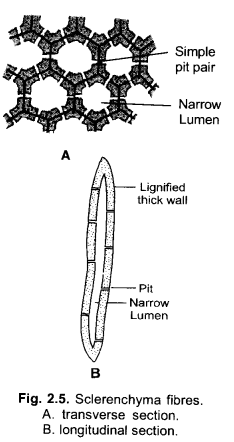
Differences between Sclerenchyma and Parenchyma

Question 17.
Describe the structure and function of different types of epithelial tissues. Draw well labelled diagrams.
Answer:
- Protection: Surface epithelium lying over the skin protects the body from drying up, microbes, chemicals and injury. A similar function of protection is carried out by epithelium lining mouth, nasal tract and alimentary canal.
- Absorption: Some epithelia have become specialised for absorption, e.g., intestinal mucosa.
- Epithelium lining the different parts of uriniferous tubules takes part in ultrafiltration, secretion and reabsorption to produce urine.
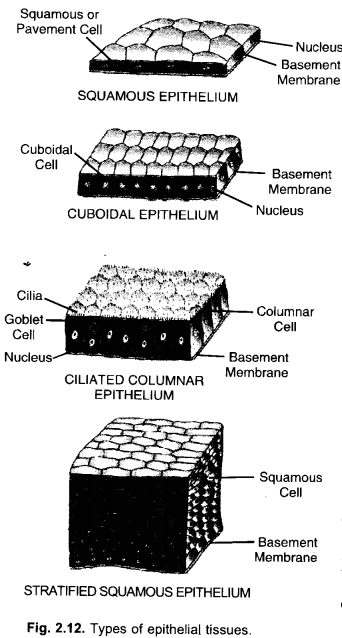
Question 18.
Draw well albelled diagrams of various types of muscles found in human body.
Answer:
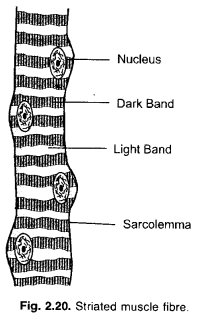
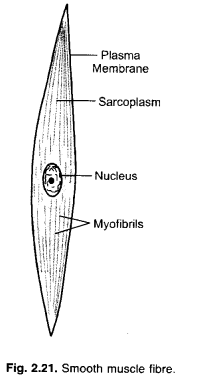
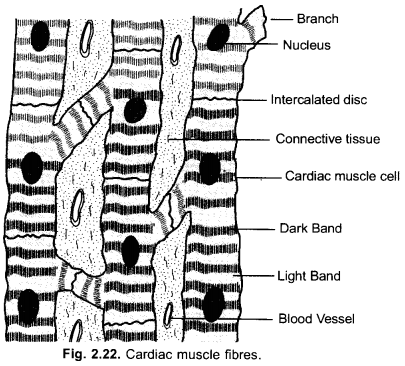
Question 19.
Give reasons for
(a) Meristematic cells have a prominent nucleus and dense cytoplasm but they lack vacuole.
(b) Intercellular spaces are absent in sclerencymatous tissue.
(c) We get a crunchy and granular feeling when we chew pear fruit.
(d) Branches of a tree move and bend freely in high wind velocity.
(e) It is difficult to pull out the husk of coconut.
Answer:
{a) They are undergoing divisions and do not store food.
(b) They have lignified walls and form bundles for mechanical function.
(c) It has stone cells or sclereids.
(d) Collenchyma provides them flexibility.
(e) Sderenchyma fibres are closely packed.
Question 20.
List the characteristics of cork. How is it formed ? (CCE 2014) Mention its role.
Answer:
(a) Characteristics:
- Outer Tissue: Cork is outer protective tissue of older stems and roots.
- Dead cells: The mature cork cells become dead and filled with tannins, resins and air.
- Compact Tissue: Intercellular spaces are absent. Cork is a compact tissue.
- Suberin: Cork cells are impermeable due to deposition of suberin in their walls.
- Multilayered: Cork consists of several layers of cells.
- Shape: Cork cells are rectangular in outline.
- Lenticels: At places cork bears aerating pores called lenticels.
(b) Formation: Cork is formed from a secondary lateral meristem called phellogen or cork cambium. It develops subepidermally in older stems and roots. Cells cut out on the outer side by cork cambium form cork or phellem while cells cut out on the inner side give rise to secondary cortex or phelloderm. The whole tissue (cork, cork cambium and secondary cortex) is called periderm.
(c) Functions:
- Protection: Epidermis is the outer protective layer of the plant that prevents entry of pathogens and pests,
- Water Loss: By presence of cuticle, it checks the rate of water loss from aerial parts,
- Hair: Occurrence of epidermal hair produces an insulating stationary layer of air. (iv) Stomata. They regulate exchange of gases. Stomata are also the seat of major loss of water in transpiration. Transpiration keeps the aerial parts cool.
- Epiblema or epidermis of the root alongwith its root hairs takes part in absorption of water and minerals.
Question 21.
Why are xylem and phloem called complex tissues ? How are they different from one another ?
Answer:
Xylem and phloem are called complex tissues because each of them is made of more than one type of cells which coordinate their activities to perform a common function.
Differences between Xylem and Phloem
| Xylem | Phloem |
| I. Conduction. It conducts water and minerals. | Phloem conducts organic solutes or food materials. |
| 2. Direction. Conduction is mostly unidirectional. | Conduction can be bidirectional. |
| 3. Channels. Conducting channels or tracheary elements are tracheids and vessels. | Conducting channels are sieve tubes. |
| 4. Components. Xylem consists of tracheids, vessels, xylem parenchyma and xylem fibres. | Phloem consists of sieve tubes, companion cells, phloem parenchyma and phloem fibres. |
| 5. Dead/Living Parts. Three of the four elements of xylem are dead (viz., tracheids, vessels and fibres). Only xylem parenchyma is living. | Three of the four elements are living (viz., sieve tubes, companion cells and phloem parenchyma). Only phloem/fibres are dead. |
| 6. Mechanical Strength. In addition to conduction, xylem provides mechanical strength to the plant. | There is little mechanical function of phloem. |
Question 22.
(a) Differentiate between meristematic and permanent tissues in plants
(b) Define the process of differentiation.
(c) Name any two simple and two complex permanent tissues in plants.
Answer:
(a) Differences between Meristematic and Permanent Tissues
| Meristematic Tissue | Permanent Tissue |
| 1. Nature. The cells are small, isodiametric and undifferentiated. | The cells are large, differentiated with different shapes. |
| 2. Spaces. Intercellular spaces are absent. | Intercellular spaces are often present. |
| 3. Vacuoles. They are nearly absent. | Large central vacuole occurs in living permanent cells. |
| 4. Nucleus. It is large and prominent. | Nucleus is less conspicuous. |
| 5. Wall. Cell wall is thin. | Cell wall is thin or thick. |
| 6. Divisions. The cells undergo regular divisions. | The cells do not normally divide. |
| 7. Metabolism. Rate of metabolism is high. | Metabolic rate is comparatively slower. |
| 8. Life. The cells are living. | The cells may be living or dead. |
| 9. Function. It takes part in growth. | It provides protection, support, conduction,photosynthesis, storage, etc. |
(b) Differentiation : The process of loss of ability to divide and taking up a permanent shape, size, structure and fucntion by newly formed cells is called differentiation.
(c)
- Simple Permanent Tissues : Parenchyma, Collenchyma, Sderenchyma.
- Complex Permanent Tissues : Xylem, phloem.
Hope given NCERT Exemplar Solutions for Class 9 Science Chapter 6 Tissues are helpful to complete your science homework.
If you have any doubts, please comment below. Learn Insta try to provide online science tutoring for you.